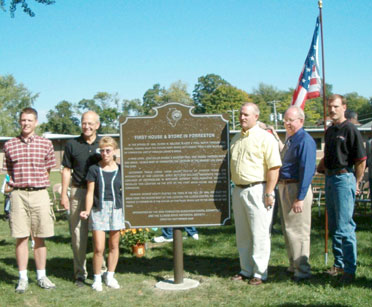|

Pictured above: Rev. David Krueger, State Rep. Jim Sacia,
Organizer Kathy Pasch,
Village Pres. Michael Harn, Master of
Ceremonies Robert Dillavou, and Superintendent Lowell Taylor.
A small piece of history along with the memory of the Ostfriesians was
preserved in Forreston on Saturday, September 17, 2005. An Illinois State Historical Marker was dedicated on the front lawn
of Forreston Grade School in Forreston, IL. The marker commemorates the First House and Store in Forreston. According to organizer
Kathy Pasch, the key piece of information in placing this marker comes from the book "The East Friesens in America" written
by Pastor George Schnucker in 1911. The book was not translated until 1985, so much of the information contained in it has
been missed in local histories. The following is quoted from the book. "The first building in Forreston of which the oldest
East Friesens could remember and which still stands today (remember this was written in 1911) is the one story brick house
north of the school. In those years, in 1855, it served as a residence and a store." This book is full of interesting information
about the settlers around the Forreston, Baileyville, German Valley Illinois area.
Old surveyor maps prior to 1841 also show secondary trails leading from
the Kelloggs and Boles trails intersecting at the site of this first house and store. When the hole was dug for the pole to
mount the marker, old bricks and square headed nails were found. The marker also pays tribute to the Kellogg Trail, the Boles
Trail, the pioneer settlers of Ostfriesland, and founder George Hewitt.
Marker wording below:
In the spring of 1825, Oliver W. Kellogg blazed a trail north through
the prairie, passing near the future West Grove settlement, then a few miles East of Forreston, and up thru Crane’s
Grove. A year later, John Boles opened a shorter trail which passed through White Oak Grove, ½ mile West of Forreston, the
location of the nearest log cabin to the town. Secondary trails linked these major routes of pioneer travel and intersected
at this location. Early settlers included immigrants from the lowlands of Ostfriesland in Northern Germany. Their narrative
accounts recalled this location as the site of the first brick house and store in Forreston. Founder George Hewitt platted
the town in the fall of 1854, and built his brick home two blocks west of this location. The Illinois Central Railroad laid
tracks to Forreston in the winter of that year, which lead to the growth of the town.
Sponsored by the Forreston Sesquicentennial Committee and the Illinois State
Historical Society. Erected September 2005.
|

